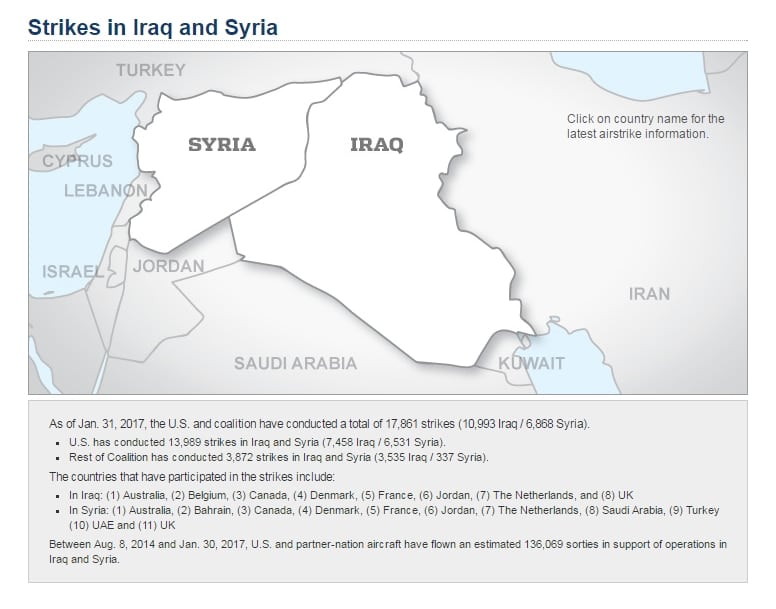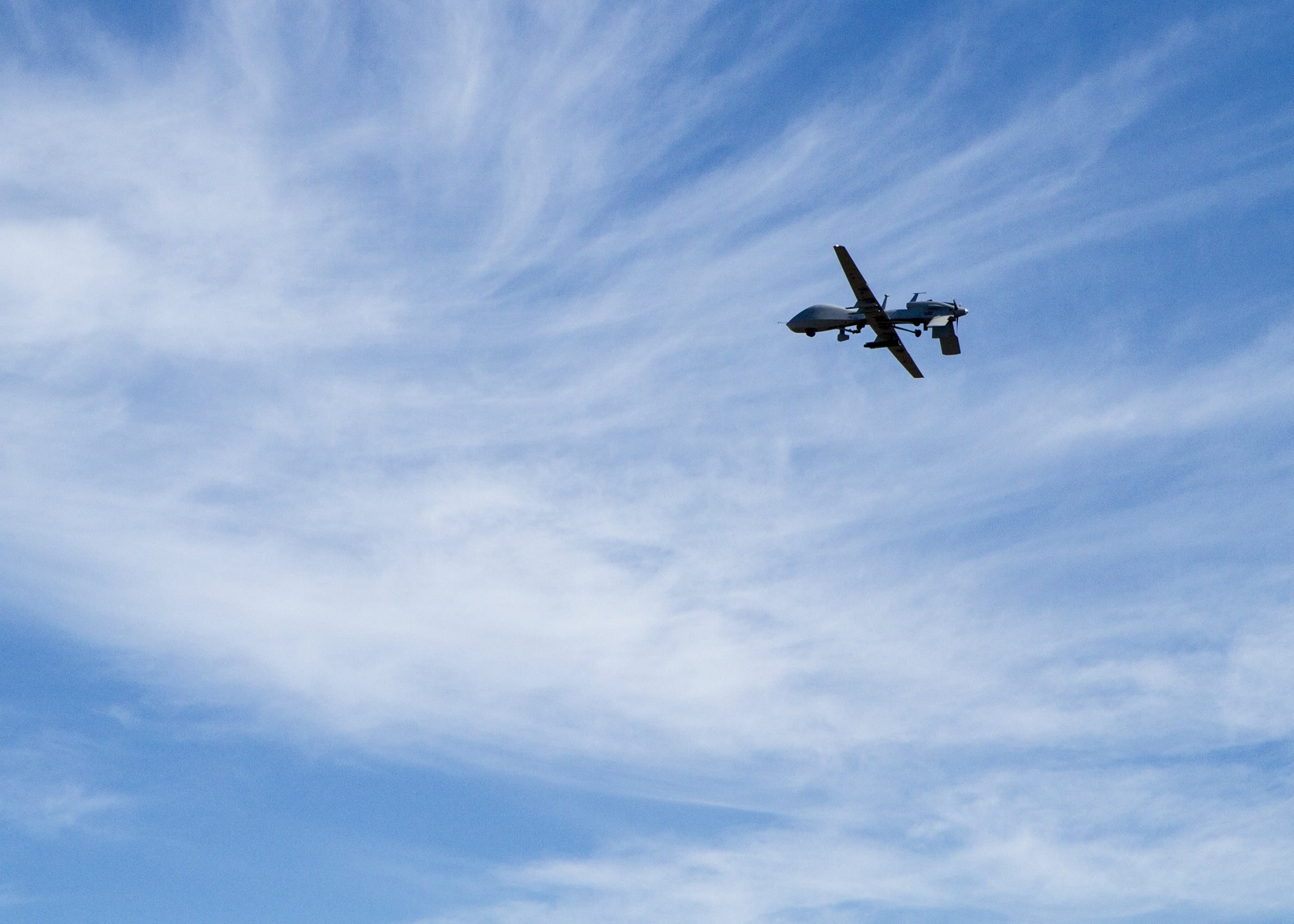The American military has failed to publicly disclose potentially thousands of lethal airstrikes conducted over several years in Iraq, Syria and Afghanistan, a Military Times investigation has revealed. The enormous data gap raises serious doubts about transparency in reported progress against the Islamic State, al-Qaida and the Taliban, and calls into question the accuracy of other Defense Department disclosures documenting everything from costs to casualty counts.
In 2016 alone, U.S. combat aircraft conducted at least 456 airstrikes in Afghanistan that were not recorded as part of an open-source database maintained by the U.S. Air Force, information relied on by Congress, American allies, military analysts, academic researchers, the media and independent watchdog groups to assess each war's expense, manpower requirements and human toll. Those airstrikes were carried out by attack helicopters and armed drones operated by the U.S. Army, metrics quietly excluded from otherwise comprehensive monthly summaries, published online for years, detailing American military activity in all three theaters.
Most alarming is the prospect this data has been incomplete since the war on terrorism began in October 2001. If that is the case, it would fundamentally undermine confidence in much of what the Pentagon has disclosed about its prosecution of these wars, prompt critics to call into question whether the military sought to mislead the American public, and cast doubt on the competency with which other vital data collection is being performed and publicized. Those other key metrics include American combat casualties, taxpayer expense and the military's overall progress in degrading enemy capabilities.
U.S. Central Command, which oversees military activity in all three war zones, indicated it is unable to determine how far back the Army’s numbers have been excluded from these airpower summaries. Officials there would not address several detailed questions submitted by Military Times, and they were unable to provide a full listing of annual airstrikes conducted by each of the Defense Department's four military services.
"It is really weird. We don’t track the number of strikes from Apaches, for example" said a U.S. military official with knowledge of CENTCOM's data collection and reporting practices. The official, who spoke to Military Times on the condition of anonymity to freely discuss internal procedures, was referring to AH-64 Apache attack helicopters, which the Army has used prolifically in combat over the last 15 years, most recently in support of American allies battling the Islamic State.
"I can tell you, unequivocally, we are not trying to hide the number of strikes," the official said. "That is just the way it has been tracked in the past. That’s what it’s always been."

It’s a significant discrepancy, though, and one for which the full scope remains unclear. Airstrikes, according to definitionsestablished and followed by members of U.S.-led coalitions, can involve fighters and other jets, attack helicopters and drones, and they can include any combination of munitions.
A single airstrike can be carried out by multiple aircraft on multiple targets, and use multiple bombs, missiles, rockets and machine gun rounds. It can include combat sorties with predefined targets and attacks carried out during the course of close air support operations.
The Army views things differently, though.
"It seems to me the collection or distribution of airstrike data is not an Army Title 10 responsibility," a senior Army official told Military Times on the condition of anonymity. Title 10 of the U.S. Code sets the laws that dictate the military services' roles, responsibilities and missions. "This responsibility should lie with the operational or combatant commander. Additionally, Apaches for example, conduct close combat attacks as a maneuver element supporting a ground force in contact with the enemy. I would not consider this in the category of 'airstrike.' "
The Air Force's open-source database includes all such missions as part of its airstrike totals. The media and others have depended on these figures for years with the understanding they are a comprehensive rollup of all American and coalition activity. And while the data has been cited in countless reports — from newspaper articles to academic research to analytics provided to lawmakers — no one from the military ever has come forward to clarify that it is wholly incomplete.
As recently as December, an Air Force official told Military Times that its monthly airpower summary of activity in Iraq and Syria specifically represents the entire U.S.-led coalition "as a whole, which is all 20-nations and the U.S. branches." It’s unclear whether this statement was intentionally misleading, or simply indicative of widespread internal ignorance, confusion or indifference about what’s contained in this data. Regardless, it does include airstrikes conducted by the U.S. Air Force, Navy and Marine Corps — but not the Army.
Financial implications, if any, are unclear. The Pentagon discloses its top-line expenditures for each of these ongoing military operations, but that data is not readily broken down by the number of sorties flown by specific U.S. aircraft and the amount of munitions they deploy. Consider, though, that Apache helicopters can carry a variety of weapons, including Hellfire missiles with a per-unit cost of $99,600, according to figures maintained by AeroWeb, a defense marketing intelligence firm that closely tracks international defense acquisition.
Such record keeping is no trivial matter. Even federal agencies routinely reference these airstrike figures in reports designed to influence Congress. Military Times’ investigation discovered multiple instances in which an inspector general drew significant conclusions, briefed to high ranking government officials working in the State Department and leading members of Congress, from open-source airstrike data.
The omission of Army strike data is one of multiple errors, discrepancies and shortcomings, raising questions about the validity of policies and methods used by the U.S. military to compile and disseminate information about its worldwide operations.
For example, a 2015 reportto Congress by the inspectors general for the Defense Department, State Department and the U.S. Agency for International Development highlighted the open-source airpower tallies for operations against the Islamic State. At some point after the report was published and briefed to lawmakers on Capitol Hill, the Air Force revised the data on which the IGs’ work was based, in some cases adding more than 100 weapons releases for a given month. And while the Air Force notes that revisions do happen occasionally, in this instance they were significant — and occurred after the information was provided to Congress.
Another discrepancy: Though it claims to use the Air Force airstrike data, the Defense Department’s public summaryof operations in Iraq and Syria, current as of Jan. 31, fails to account for nearly 6,000 strikes dating to 2014, when the air campaign against ISIS began.
The most recent Air Force summary counts 23,740 coalition airstrikes through 2016. Meanwhile, the Defense Department's website lists 17,861 through Jan. 31. The Pentagon routinely cites these figures when updating the media on its operations against the Islamic State and al-Qaida affiliates in Iraq and Syria.

In this screen grab of the Defense Department's website, taken Saturday, Feb. 4, officials have tallied 17,861 coalition airstrikes through Jan. 31. That's nearly 5,900 fewer than the Air Force's tally through the end of December 2016.
There also appear to be separate policies in place regulating the specificity of information that may be publicly disclosed. Citing policy, military officials in the U.S. and in Baghdad refuse to identify the type of American warplanes that conduct individual airstrikes in Iraq and Syria, nor will they provide a breakdown of activity by individual service components.
It’s another story entirely in Afghanistan, where U.S. military officials, in response to questions from Military Times, volunteered the previously undisclosed Army airstrike data for 2016, even identifying the four types of Army aircraft providing lethal air support there. Navy Capt. William Salvin, a spokesman for U.S. forces in Afghanistan, said that in addition to Apaches, there are armed UH-60 Blackhawk helicopters and MQ-1 Gray Eagles, which are drones. Initially, Salvin indicated the Army's RQ-7 Shadow drones also are armed, but he later corrected that statement.

An MQ-1C Gray Eagle conducts live fire training at Fort Stewart, Georgia. The Army uses this drone in Afghanistan and other theaters to conduct airstrikes in addition to intelligence collection.
Photo Credit: Sgt. William Begley/Army
Salvin also explained that the airstrikes conducted there — 1,071 total for last year, not 615 as the Air Force reports in its open-source database — are further classified by three categories: self defense, counter terror and strategic effects, which may be required when senior commanders believe U.S. firepower could help turn the tide in regions deemed vital to Afghanistan's broader stability.
"We’re just trying to be transparent here," said Army Brig. Gen. Charles Cleveland, the top spokesman for Operation Resolute Support, which includes the American military’s ongoing effort to train and advise the Afghan army and air force. A separate, smaller operation in Afghanistan, called Freedom’s Sentinel, involves U.S.-led counter-terrorism efforts against al-Qaida and its numerous affiliates in the region.
"What you’re talking about is a larger policy decision that would likely start at OSD," Cleveland said when asked whether these reports should become all inclusive. OSD stands for the Office of the Secretary of Defense. "It’s probably larger than a CENTCOM policy decision. What you’re talking about is a global laydown because there are strikes in AFRICOM."
U.S. Africa Command oversees many of the military’s most secretive counter-terror operations throughout the continent, to include Somalia and Libya. Those tallies are not routinely disclosed either.
Cleveland emphasized, too, that the United States’ air campaign in Afghanistan is part of a greater effort, now in its 16th year, to mentor, support and protect the Afghan military with hopes it will be able to independently provide the country’s security. "The overall concept of airstrikes," the general said, "from anybody, is a small part of a larger mission."
It remains unclear why the Army is unique in excluding its airstrike figures from these broader summaries and reports. Reached Saturday, a spokesman for Army headquarters in Washington declined to comment, saying he was unable to research the matter on short notice.
The U.S. military official who spoke on the condition of anonymity said it’s because Army aircraft flown in war zones don’t fall under the Air Force chain of command responsible for publishing these monthly summaries.
Still, that does not answer why the Army does not disclose its airstrike data.
Kenneth Roth, executive director of Human Rights Watch, a research and advocacy organization, called transparency essential to military accountability. That requires "honest reporting to the public," Roth said.
"Security may at times require secrecy," he added, "but embarrassment or political sensitivity never should. Facts regarding the number of airstrikes and their civilian toll should always be disclosed promptly and faithfully so the public, aided by human rights workers and journalists, can scrutinize military operations being conducted in their name."
Andrew deGrandpre is Military Times' senior editor and Pentagon bureau chief. On Twitter: @adegrandpre.
Shawn Snow is a staff writer and Military Times' Early Bird editor. On Twitter: @SnowSox184.
With additional reporting by Air Force Times' senior writer Stephen Losey. On Twitter:
.
Shawn Snow is the senior reporter for Marine Corps Times and a Marine Corps veteran.





